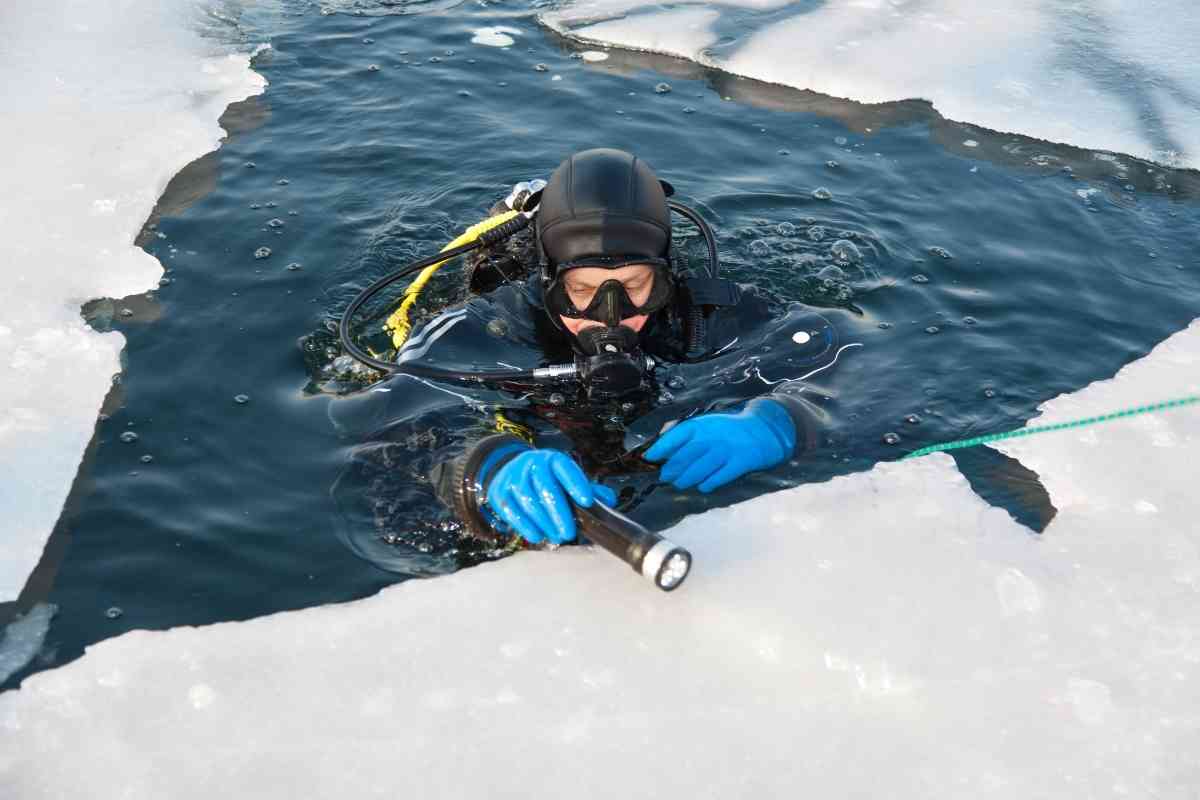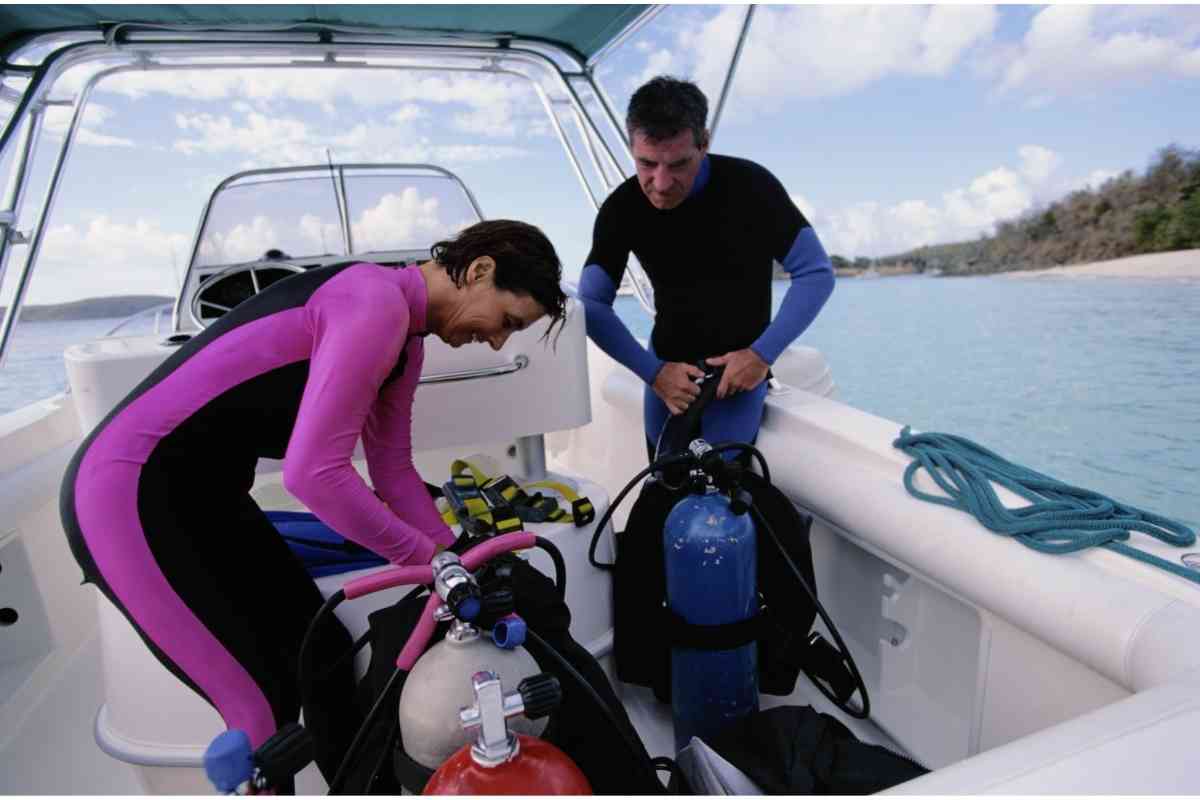What is a dry suit? And what is a wet suit? And how do these garments differ from one another?
Both of these accessories are terrific for protecting your body when you enjoy water activities like scuba diving, snorkeling, kayaking, rowing, and many others. But the functioning and benefits these suits offer are quite different.
In this guide, we discuss the main differences between a wetsuit and a drysuit, and we review two of the best products to consider for your next big aquatic adventure.

What Is a Dry Suit?
A drysuit is a full-body suit that’s water-tight so you can stay dry while you are swimming, surfing, or doing other types of water activity.
Drysuits are mostly made from rubber or neoprene and usually have a sturdy exterior shell with rubber seals around the neck, ankles, and wrists that keep water out. These suits have a long waterproof zipper in the front so you can easily get in and out of the suit.
These suits are made from rubbery waterproof materials, and the closures are reinforced to create a water-tight seal around zippers.
Around the neck and wrists, the suits also have rubber seals that consist of two parts: an inner and outer seal. The gaskets or seals are made from flexible rubber so they can fit comfortably around your skin and form a water-tight seal without feeling too uncomfortable.
The foot parts of a dry suit are a lot like a babygrow, since it has built-in socks that also seal in this part of your body. Wearers do, however, wear a special type of boot over this part of the suit to keep rocks from puncturing the suit and ruining its watertight seal.
The suits do have a skin-tight fit, but can be purchased in a bigger size so you can wear other types of clothing underneath.
A lot of surfers prefer to wear their swimming costumes underneath the dry suit, but in extremely cold temperatures, people often wear insulating clothing like fleece or warm cotton underneath the suit.
The suits are not insulated, which means they might keep you dry, but they won’t keep you warm, unless you add an additional layer of clothing.
How Drysuits Work
When you enter water below 98 degrees F, as most natural bodies of water are, your body will start to cool down. The colder the water is, the quicker the human body cools down.
Your body loses warmth 25 times faster in water than it normally would in cold outdoor air temperatures. But, because your body isn’t in direct contact with the water due to the water-tight seal of the drysuit, your body retains some of its heat for longer.
The drysuit can also be worn over additional clothing. In cold temperatures, you can wear long johns or fleece undergarments to insulate your body from the cold. This layer will keep your body warmer while the drysuit keeps water from saturating your insulative layer.
Do You Get Wet in a Dry Suit?
Drysuits are designed to keep water away from your skin, and any clothing you wear under the drysuit should stay perfectly dry. There are, however, a few exceptions.
You can still get wet from your perspiration, and you might get wet if there is a leak in your drysuit or if it doesn’t seal properly around your neck.
Can You Swim in a Drysuit?
You can swim or go diving in a dry suit. These suits are specially developed to keep you dry in icy cold temperatures. Some people do, however, find drysuits a bit bulky for casual swimming.
Air also sometimes gets trapped inside the drysuit and bulks around your arms, making it hard to dive down. If you are planning on swimming in a drysuit, then it is best to find one with a skin-tight fit.
What Is a Wet Suit?
Wetsuits are designed to offer thermal protection and use your body as a heat source.
These suits are made from closed-cell foam that consists of millions of tiny gas bubbles trapped in the material structure. When you put the suit on, it will fill with water, and this thin layer of water will soon warm up from your body temperature.
The thermal layer the warm water creates is perfect for keeping your body warm for longer because it acts as a barrier to keep the cold at bay.
When you buy a wetsuit, you will need to get a tight-fitting suit, because if it is too loose, water can easily flow in and out of your suit and the thermal properties will be lost.
Wetsuits are available in different styles and designs, and the thickness of the material can differ. The thicker the wetsuit is, the more protection from the cold it will offer, while thinner wetsuits are more practical for warmer climates.

How Wetsuits Work
When you get into the water, the wet suit will fill the space between the suit and your skin with water.
Within minutes, this thin layer of water warms up from your body temperature, but is locked into the suit to form a barrier that keeps exterior cold water from getting close to your skin.
The warmth of the water inside the wetsuit keeps your body temperature trapped so you won’t lose heat when you dive down into deep waters.
Do You Get Wet in a Wetsuit?
Yes, you do get wet in a wetsuit. These suits are designed to allow a thin layer of water in so your body temperature can warm up the thin layer of water.
Once warmed, this thin layer of water remains trapped against your skin and acts as a barrier that keeps cold water from reaching your skin.
The thin layer of water insulates your body and keeps you from losing too much body heat when you go swimming, diving, or snorkeling in icy cold water.
Can You Swim in a Wetsuit?
Yes, neoprene suits are designed for swimming, diving, scuba diving, snorkeling, and surfing in cold water temperatures.
The suit insulates your body so you can swim for longer without feeling too cold or without losing too much body heat.
Some of the warm water might escape from the wetsuit if you move a lot and will then be replaced with cold water. This is why wetsuits are usually not worn for athletic purposes.
What Are the Differences Between Wet and Dry Suits?
There are quite a few differences between wetsuits and drysuits. Here is a quick look at the main differences:
Materials
Drysuits are made from rubber or neoprene. Wetsuits are mostly made from closed-cell foam.
Waterproofing
Drysuits are waterproof with neck seals and wrist seals and keep all water away from your skin and clothing. Wetsuits allow water in so your body temperature can warm up the water and insulate your body.
Undergarments
With a dry suit, you can wear other clothing, including warm wear, to insulate your body for extra protection. With a wetsuit, it is best not to wear too much because all your clothing will be saturated.
Fit
Wetsuits are usually skin-tight in order to keep warm water trapped against your skin and to keep cold water out. Drysuits usually have a looser fit so you can wear clothing underneath.
There are, however, different types of wetsuits. Some are skin-tight for swimming and others are looser so you can wear thicker clothing underneath.
Thermal benefits
Drysuits usually don’t offer any thermal protection all on their own, but the suit will keep your clothing dry.
If you wear thermal wear underneath the drysuit, you can keep your body temperature nice and warm in cold weather, and the drysuit will keep the thermal wear nice and dry so you will stay warm.
Wetsuits naturally insulate your body as soon as the water trapped against your skin heats up. The thermal insulation they provide is great for cold climates, but this might not be the best wear for active water sports because movement can let in colder water.
Use
Wetsuits are mostly used for swimming or water sports like diving, snorkeling, swimming, and surfing. These suits are more practical for cold water temperatures and are designed to be used inside the water.
Drysuits, on the other hand, have a greater application since they can be used inside and outside the water and still offer the same waterproofing benefits.
These suits are also practical for swimming and water sports like dry suit diving, but they are often used for recreational activities where the wearer isn’t submerged in the water.
Drysuits are also more practical for work purposes since they will keep you nice and dry when you work on a dock, boat, or when you work in the rain.
Mobility
Wetsuits are easier to move in because they usually have a skin-tight fit. Some drysuits can also fit snugly and offer good mobility, but they are usually baggier so you can wear other clothing underneath. This extra bulk can make it a little bit more difficult to move around in the water.
The Best Drysuit for Water Sports
Drysuits are sold by many different brands, and there are quite a few different types available on the market. Up next, we’ll take a quick peek at the top dry suits for swimming or kayaking.
Here’s a quick look at our two top choices.
1. The ZOCCO Ultra Stretch Full Body Diving Suit – The Best Wet Suit for Swimming

This skin-tight, all-black wetsuit looks very stylish with its Zocco logo on the chest and arrow markings along the pant leg. It’s only available in black, but you can get it in a huge variety of sizes in both men’s and women’s versions.
The diving suit is made from 3mm neoprene fabric that consists of 4.9% rubber and 10% nylon. This fabric is specially designed to let a little bit of water (2.5mm) into the suit so your body can warm up the water for insulation purposes.
The front zipper makes it very easy to get the suit on, and the water stop seal at the collar, legs, and wrists keeps the warm water from exiting so icy water won’t enter to make you feel chilly.
This wetsuit consists of anti-abrasion knee pads that will keep your knees protected when you go diving or when you accidentally snag your knees on a rock.
Most buyers find the water suit true to size and that it maintains a good level of flexibility since the fabric isn’t too stiff.
This wetsuit is ideal for various water temperatures and will keep you nice and snug at around 84 degrees F water temperatures. It’s a great suit for beginner divers since the suit is practical for diving depths of up to 60 feet.
Specifications
- Colors: Black
- Sizes: Women’s and men’s X-small to XX-large
- Weight: 1.36 Kilograms
- Material: 3mm Neoprene
- Sport type: Diving, snorkeling, and surfing
- Closure type: Water-tight zipper on chest, arms, and legs
- Sleeve type: Long sleeve
- Waterproof: Lets water in, but has a water stop seal to keep water trapped
- Windproof: Yes
- Self-draining: Yes
- Adjustable: No
Pros
- Well-made
- Ideal for up to 60ft diving
- Suitable for water temperatures around 84F
- Comfortable enough for long hours of wear
- The suit is nice and flexible so you can move with ease
- Easy to put on and take off
- Available in various sizes and for men and women
- Will still be functional if punctured
Cons
- Sizes run small
- Not a drysuit
2. The Mookta Waterproof Drysuit for Men – The Best Dry Suit for Kayaking

The drysuit is made from 3 layers of waterproof materials in order to create a water-tight seal that will keep your clothing and body dry, even when you go swimming. The suit also has gaskets around the neckline and wrists to keep water from getting into your suit at these points.
Unlike the Zocco wetsuit, this drysuit has a looser fit so you can layer with a fleece outfit and keep your body insulated from the cold. The ability to layer clothing makes this suit perfect for various weather conditions.
For warmer weather, you can wear the suit as is, but for colder temperatures, you can layer with insulating long-sleeve clothing.
It’s a very practical suit for swimming, but lots of people use it for boating or kayaking because it also offers wind protection.
The unique fabric also keeps you from swelling like a pufferfish because it will let some air out when you go diving or snorkeling. This feature makes it easier to dive down to greater depths without too much weight.
The suit is available in four different colors, and, even though it isn’t skin-tight, it does offer a very good overall look. It also has zipper pockets on the front for keeping certain valuables like car keys close by and dry, even if you happen to fall into the water.
Specifications
- Colors: Yellow, black, blue, or red
- Sizes: Small to XXL
- Material: Nylon
- Sport type: Boating, snorkeling, diving, swimming, kayaking, and surfing
- Closure type: Waterproof zipper
- Sleeve type: Long sleeve
- Waterproof: Yes
- Windproof: Yes
- Self-draining: No
- Adjustable: Slightly
Pros
Cons
Final Thoughts
We hope that this guide sufficiently answered the question “what is a dry suit” and offered all the information you needed for understanding the differences between wet suits and dry suits.
We also hope that you found our buyer’s guide helpful on your journey to finding the perfect suit for your water sport.
If you want to learn more about scuba diving or want to shop for more gear, then you should check out more of our posts at Scuba Diving Books!
